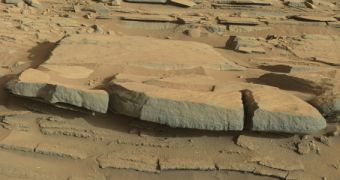Mission controllers for the NASA Mars Science Laboratory (MSL) rover Curiosity announced recently that the 1-ton explorations robot has just reached Kimberly, a feature on the floor of Gale Crater that provides multiple exposed, rocky outcrops for study. The robot will most likely stop in this area for a while and perform drilling and contact science on these interesting materials.
Scientists at the NASA Jet Propulsion Laboratory (JPL), who manage Curiosity for the NASA Science Mission Directorate in Washington, DC, say that the rover managed to reach Kimberly last week. Lately, the robot has been navigating a series of sand dunes that stand between these outcrops and Dingo Gap. The latter is a passageway through some rocky ledges that was passed 6 weeks ago.
The robotic arm on NASA's largest exploration rover has already been extended and its suite of scientific instruments prepared for contact science. Experts hope that the extremely detailed structures on the surface of these rocks will provide them with a deeper understanding of Mars' distant past.
Curiosity has not conducted any meaningful drilling campaigns since July 2013, when it departed Yellowknife Bay, a dried-out lake bed in Gale Crater. The rover's main target remains the 5-kilometer-tall (3-mile-tall) Mount Sharp, which can be seen in the backgrounds of most images collected to date.
JPL experts say that the explorations robot reached the edge of Kimberly on March 20, or Martian day (sol) 576. Images collected from this location revealed numerous similarities between this feature and Junda, an outcrop located about 1 kilometer (0.6) miles behind the rover that was surveyed in mid to late February, Universe Today reports.
“The images [snapped at Kimberly] show nice outcrops in front of the rover, suitable for contact science,” says science team member Ken Herkenhoff, who holds an appointment with the Astrogeology Science Center at the United States Geological Survey (USGS).
Over the weekend, Curiosity has used its mast-mounted ChemCam laser to zap the rocks in front of it. The laser is so powerful that it can vaporize rocks, so the rover can use its spectrometer instruments to determine the chemical composition of these materials. Additionally, cameras on the robotic arm were used to take a closer look at the outcrops.
The SAM and CheMin miniaturized chemistry labs, which lie inside Curiosity, will soon receive some Martian dirt and rock samples for analysis. JPL mission controllers ordered the rover to clean its CHIMRA sample-handling mechanism, also installed on its robotic arm. This device will be used to move samples from the Martian surface to inner ovens, which will then figure out their internal makeup.
“At Kimberly, we see three terrain types exposed and a relatively dust-free surface,” explains Katie Stack, a science team collaborator who is based at the California Institute of Technology in Pasadena.

 14 DAY TRIAL //
14 DAY TRIAL //